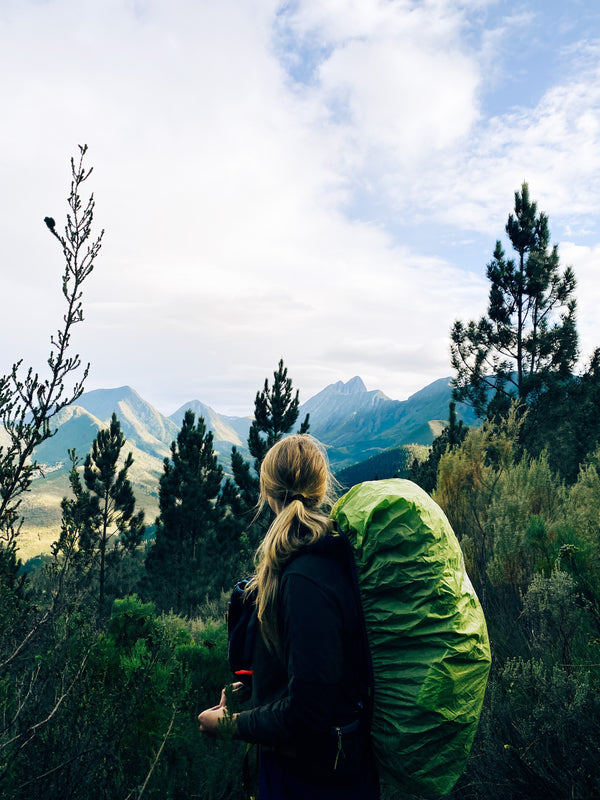September 2025

The Wupperthal66 is a brand-new four-day slackpacking trail deep in the Cederberg Mountains, stretching over ±66km. It’s not just about covering distance — this is an immersive wilderness experience through ochre-coloured valleys, dramatic rock formations, and remote canyons, paired with authentic hospitality from the Wupperthal community.
-
Beauty Rating: 5/5 – From sandstone cathedrals and rugged mountains to hidden valleys and ancient rock art, this trail is a visual feast. The remoteness of the Cederberg makes it feel untouched, almost like stepping 100 years back in time.
-
Difficulty Rating: 7/10 – Expect long hiking days, steep climbs, and uneven terrain. Good fitness required.
-
Technical Rating: Mostly trail walking with a few scrambles and rocky descents. Nothing extreme, but this is true mountain hiking.
Day 1: Drakie Camp to Eselbank Waterfall Area (±18 km)
Elevation: 423m up, 470m down | Difficulty: 6–6.5/10
The trail begins after a short vehicle transfer to Wupperthal for safe parking. Starting from Drakie Camp, the route follows a two-track path through Speelkloof, passing the communities of Grashoek, Kleinvlei, Brugkraal, and Agterstevlei. Traditional farming methods are still practised here, giving you a glimpse of local life. The track follows a perennial river, perfect for a refreshing dip. Around 11km in, the path narrows into a local footpath leading toward Kleinvlei, with dramatic rock formations guiding the way. Camp is set up near the spectacular Eselbank Waterfall.



Day 2: Eselbank Waterfall to Martiensrus (±20 km)
Elevation: 68m up, 400m down | Difficulty: 6–7/10
Start the morning at the beautiful Eselbank Waterfall before hiking through sandy tracks lined with proteas. The route passes through the Eselbank community and across a rocky plateau to the natural sandstone arch known as Ereboog(Honorary Arch) — a spot locals call one of the most beautiful in the Cederberg. From here, descend via a steep single track used daily by villagers to access remote valleys. The final stretch follows a stream into the secluded Martiensrus outpost, where hikers are welcomed with warm hospitality and a special local treat: homemade Rooibos ginger beer. Overnight at Akkeba Camp beside the stream.
And then comes a true cultural highlight: the Riel dance. Known as South Africa’s oldest indigenous dance, the riel was born in the dusty landscapes of the Karoo and Cederberg. Around the evening fire, locals showcase this high-energy performance — a mix of foot stomping, playful courtship gestures, and storytelling through movement. Watching the community dance under a star-filled sky connects you to a tradition that has survived centuries, passed down from San and Khoi ancestors. It’s not just entertainment, but living heritage, and it’s often described as one of the most memorable parts of the Wupperthal66 journey.


Day 3: Martiensrus to Vaalheuning (±15.5 km)
Elevation: 655m up, 336m down | Difficulty: 8.5/10 (steep section pushes rating up)
Though shorter in distance, this day is one of the toughest. The trail includes steep inclines and a rugged climb that opens to panoramic views: the gorges of the Cederberg on one side and the vast plains of the Tankwa Karoo on the other. The highlight comes at the top, where you look down on Wupperthal village and trace the previous days’ paths from above. The day ends at Vaalheuning, Wupperthal’s most remote outpost, accessible only by 4x4. Its seclusion makes it an unforgettable overnight stop.



Day 4: Vaalheuning to Wupperthal (±12.5 km)
Elevation: 139m up, 564m down | Difficulty: 4–5/10
The final day is a descent into Wupperthal. The trail is split into three sections: the first 3km flat, the next 6km downhill on loose rock, and the last 3km flat again. The 4x4 track leads into the valley, with wide views of sandstone cliffs and endless mountains. Finally, you enter Wupperthal’s historic main street, lined with whitewashed houses, before finishing at the historic Moravian church — the heart of the community. Many hikers describe this arrival as a pilgrimage moment, more moving than any finish line.


General Recommendations
-
Best Season: Autumn (March-April) or spring (August–Ocotber) for cool temperatures and clear skies. Summers can be extremely hot.
-
Slackpacking: Bags are transported by the support team, leaving you free to hike with only daypacks. Expect warm meals and fireside hospitality each evening, despite the remoteness.
-
Accommodation: Camps are set up in wilderness areas, with limited access. Two overnight spots can only be reached with 4x4, adding to the wilderness feel.
-
What to Pack in Your Daypack: Water, snacks, rain jacket, headlamp, hat, warm top, first aid essentials, and swimming gear for the natural pools en route.
-
Trail Access: The hike is operated by Live the Journey in collaboration with the Wupperthal community, ensuring both conservation and local upliftment.
If you’re inspired by Wupperthal66, Live the Journey offers more ways to explore this remarkable region. The Wupperthal Cedar Trail is a slightly shorter journey, ideal for those looking for a balance of hiking and cultural immersion. For seasoned hikers craving an even greater challenge, the Wupperthal100 stretches over 100km — a bold test of endurance across the wild heart of the Cederberg.
👉How to book
-
https://www.livethejourney.co.za/tour/wupperthal-cederberg-hike/
-
CAPE TOWN OFFICE: +27 21 863 6400
-
EMAIL: info@livethejourney.co.za


